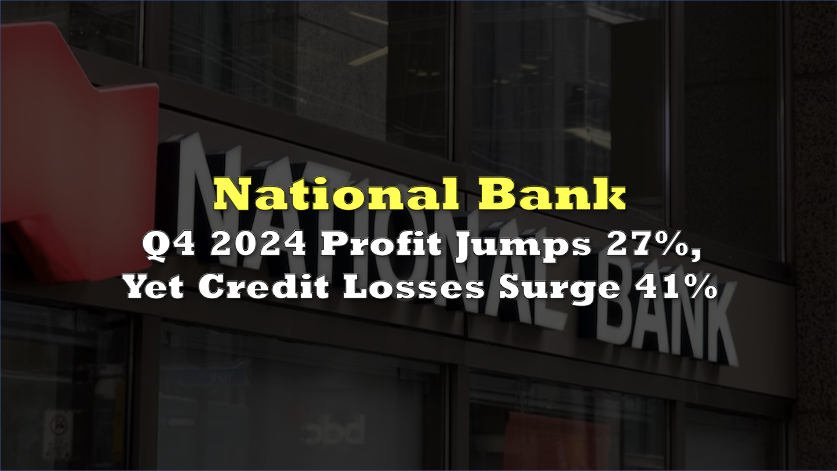National Bank of Canada (TSX: NA) reported its Q4 2024 financials, ending the quarter with a net income of $955 million, a 27% increase from $751 million in the fourth quarter of 2023. Diluted earnings per share (EPS) rose in tandem, reaching $2.66 compared to $2.09 in the same period last year.
When adjusted for specified items, net income grew to $928 million, an increase of 9%, and adjusted diluted EPS climbed to $2.58, reflecting an 8% rise. While these figures reflect strong growth, the quarter-over-quarter trend shows a slower momentum; adjusted net income grew only marginally from $920 million in Q3 2024, with adjusted EPS increasing from $2.57.
For the full fiscal year, net income reached $3.82 billion, a 16% rise from $3.29 billion in 2023, while diluted EPS increased by 16% to $10.68, up from $9.24. Adjusted figures for fiscal 2024 were similarly robust, with adjusted net income growing 10% to $3.72 billion and adjusted diluted EPS climbing to $10.39, also a 10% increase.
Revenue growth was a standout driver, with total revenues for Q4 2024 climbing to $2.94 billion, a 15% increase from $2.56 billion in Q4 2023. This growth was primarily fueled by strong showings in Wealth Management and Personal and Commercial Banking, offset by flat performance in Financial Markets. On an annual basis, total revenues reached $11.4 billion, up 13% from $10.06 billion in fiscal 2023.
Adjusted revenues for Q4 rose 10% year-over-year, while for the full year, adjusted revenues increased by the same 10%, indicating consistent growth after accounting for specified items. However, comparing Q4 to the previous quarter, revenues grew by just 3%.
Non-interest expenses were a mixed bag. For Q4 2024, expenses stood at $1.59 billion, slightly below the $1.60 billion reported in the same period last year, reflecting cost discipline. However, when adjusted, expenses rose to $1.58 billion, marking an 8% increase from Q4 2023.
For the year, non-interest expenses totaled $6.05 billion, a 5% increase from $5.75 billion in fiscal 2023, driven by similar factors. While the efficiency ratio improved to 54.1% in Q4 from 62.4% a year earlier, the adjusted ratio barely improved, from 53.6% to 52.9%, raising questions about the bank’s ability to drive further efficiency gains.
Loan growth remained a bright spot, with loans and acceptances rising 8% year-over-year to $243 billion, driven by a 7% increase in residential mortgages and a 10% increase in business and government loans. Deposits grew even faster, up 16% to $333.5 billion, reflecting strong customer acquisition and funding initiatives.
However, provisions for credit losses (PCL) surged to $162 million in Q4 2024 from $115 million in Q4 2023, a 41% increase. For the full year, PCL reached $569 million, up 43% from $397 million in fiscal 2023. This increase, attributed to normalization in credit performance, particularly in personal banking, raises concerns about credit quality as higher interest rates and a slowing economy take hold.
Wealth Management saw revenues rise 14% year-over-year in Q4 2024, supported by fee-based revenues, which grew 15%, and net interest income, which rose 13%. This segment delivered an impressive 41% increase in net income to $219 million in Q4, compared to $155 million a year ago. However, adjusted net income grew at a more modest 17%.
The Financial Markets segment, however, faced headwinds. Total revenues in Q4 2024 declined slightly by 1% to $728 million from $735 million in Q4 2023, driven by an 11% drop in equities trading revenues. Net income for the segment rose 8% to $306 million, but this was partly due to lower provisions for credit losses.
The U.S. Specialty Finance and International segment continued to deliver robust growth, with revenues up 21% year-over-year in Q4 2024 to $378 million, driven by ABA Bank in Cambodia and Credigy’s U.S.-based activities. Net income for this segment grew by 8% to $157 million in Q4 and by 15% to $628 million for the full year, underscoring its importance as a growth engine. However, provisions for credit losses in the segment surged by 173% in Q4.
Capital management remains a strong point for the bank, with a Common Equity Tier 1 ratio of 13.7% as of October 31, 2024, up from 13.5% a year earlier. This improvement reflects earnings retention and disciplined risk management, though the ratio could face pressure in 2025 due to the expected $5 billion acquisition of Canadian Western Bank. The transaction, set to close next year, is expected to boost National Bank’s presence across Canada.
National Bank of Canada last traded at $140.76 on the TSX.
Information for this briefing was found via Sedar and the sources mentioned. The author has no securities or affiliations related to this organization. Not a recommendation to buy or sell. Always do additional research and consult a professional before purchasing a security. The author holds no licenses.









